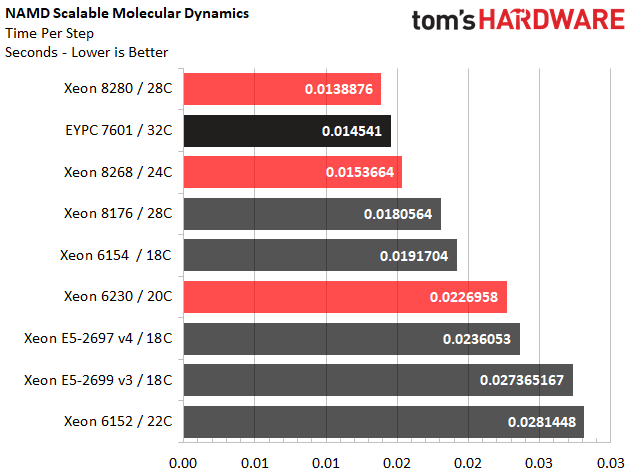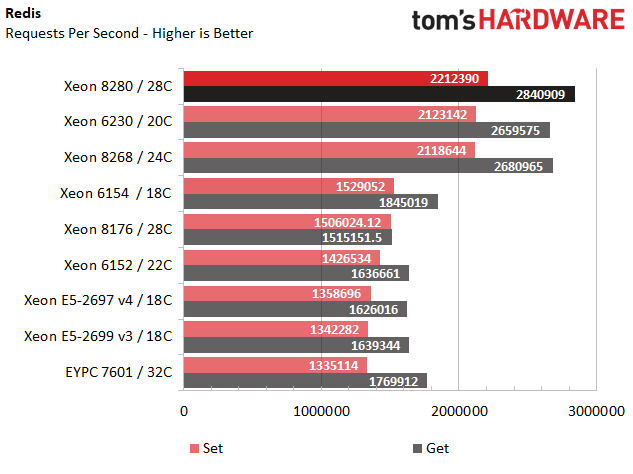Intel Cascade Lake Xeon Platinum 8280, 8268, and Gold 6230 Review: Taking The Fight to EPYC
Why you can trust Tom's Hardware
Linux Compile, Unix Bench, NASPB
Linux Compile
We began our tests with a Linux compile test (Kernel 4.4.2).
The Xeon Platinum 8280 takes a solid lead against the Xeon 8268, which is trailed by the EPYC 7601. The Xeon 8268 scores a nice gain over the previous-gen Xeon 8176. Even though they're both 28-core processors, the 205W Xeon 8268 is a notch higher in the product stack than the previous-gen 165W Xeon 8176, meaning these processors aren't directly comparable.
We also see the impact of the 18-core Xeon 6154's 900 MHz Turbo Boost advantage over the 22-core 6152. As you peruse our test results, bear in mind that the 22-core 6152 is a 140W part, while the 18-core 6154 is rated for 200W.
Unix Bench 5.1.3
Unix Bench is an open source GPLv2-licensed suite that originated in 1983 at Mondash University. Byte Magazine then updated and expanded the set of metrics. It includes nine benchmarks that quantify various aspects of system performance. We focus on Dhrystone and Whetstone specifically. The former isolates string handling; there are no floating-point operations. Whetstone measures the speed and efficiency of floating-point operations typically employed in scientific applications.
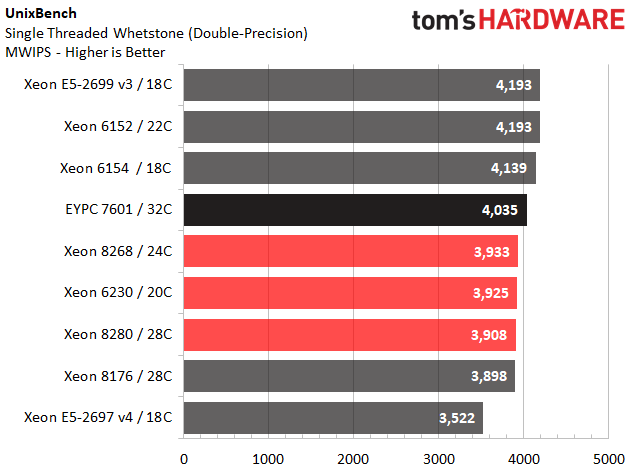



The Cascade Lake 6230 and 8268 offer impressive single-threaded integer performance, pushed along by the 3.9 GHz Turbo Boost speeds. But the 28-core 8280 takes a slim lead courtesy of its higher 4.0 GHz bin, while the EPYC 7601 falls to the bottom of our test pool.
The 8280's performance advantage doesn't carry over entirely to the single-threaded Whetstone test, which finds the EPYC 7601 leading Intel's Cascade Lake line-up. Whetstone addresses a minuscule amount of data that tends to reside entirely in L1 cache, likely affording the 7601 an advantage due to its 3MB of L1 (I$-2MB/D$-1MB) compared to Cascade Lake's 1.5MB (I$-768K/D$-768K). Meanwhile, slight differences in single-core Turbo Boost frequencies between the Cascade Lake models result in minimal variation between the models.
The Xeon 8280 stretches its legs in the multi-threaded Whetstone test as it takes the lead, while the EPYC 7601 brings its 32 cores to bear, taking second place. That's impressive for a processor that costs less than half of Intel's 8280. The 24-core Xeon 8268 edges out the previous-gen 8176. But remember that these are 205W and 165W processors, respectively.
Get Tom's Hardware's best news and in-depth reviews, straight to your inbox.
NAMD Scalable Molecular Dynamics
NAMD is a parallel molecular dynamics workload that performs high-performance simulations of large biomolecular systems. It's designed to test the boundaries of parallel computing by scaling up to 500,000 cores. The Theoretical and Computational Biophysics Group at the University of Illinois at Urbana-Champaign developed and maintains the project, which is the recipient of several prestigious awards.
This floating-point-heavy test tends to value core count above all else, though frequency also plays a role. It isn't surprising to find the Xeon 8280's 28 cores taking the lead in this AVX-optimized workload. AMD's EPYC 7601 delivers ~95% of that chip's performance, though, which is impressive given a much lower price point.
NAS Parallel Benchmarks
The NAS Parallel Benchmarks (NPB) are a set of programs developed by the NASA Advanced Supercomputing Division to evaluate the performance of parallel supercomputers. The suite characterizes Computational Fluid Dynamics (CFD) applications, and NASA designed it to measure performance from smaller CFD applications up to "embarrassingly parallel" operations. The FT test characterizes a 3D partial differential equation using Fast Fourier Transform, while BT measures Block Tri-Diagonal solver performance.
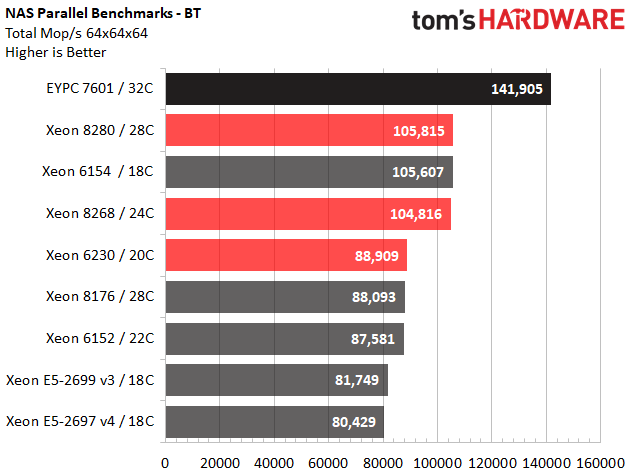

The EPYC 7601 takes a commanding lead in the NASPB BT test, impressing us during the FT workload as well. Meanwhile, the 24-core 8268 leads the 28-core 8280 in the FT benchmark, likely due to its higher base frequency. We also suspect that sub-optimal scaling affects the Cascade Lake processors, as we see a similarly small delta in the BT benchmark. The 8268 does have a higher base frequency than the 8280, but other factors may also come into play, like the eccentricities of Intel's mesh architecture.
Redis
REmote DIctionary Server (Redis) is a popular in-memory data structure store that is used as a database, cache, and message broker. It's dependent on both CPU performance and memory bandwidth. Redis is open source (BSD-licensed) software.
Memory throughput plays a big role in this test, and Redis is a single-threaded workload, so it's indicative of per-core memory throughput and performance. The 8280 has the highest single-core Turbo Boost bin of the bunch, so naturally we find it at the top of the heap. The inverse is true of the 7601. Its Turbo Boost frequency is the lowest in this group, relegating it to the bottom of our chart. A multi-threaded in-memory database would extract much more performance from the 7601's available throughput and high core count.
Open SSL
SSL (Secure Sockets Layer) is the go-to technology for securing encrypted links between a server and client. It's an important protocol for every level of the Web in today's security-conscious climate.
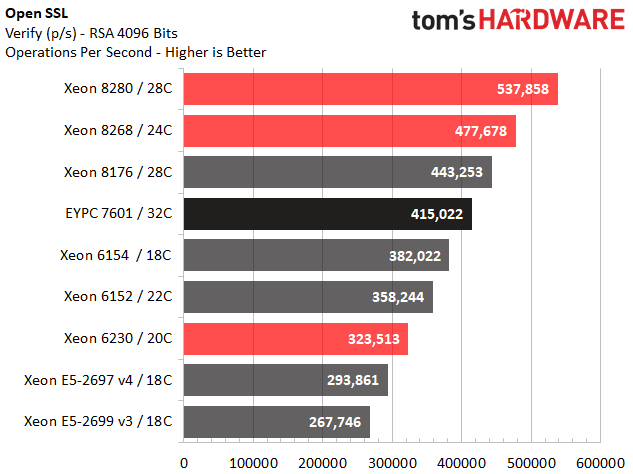
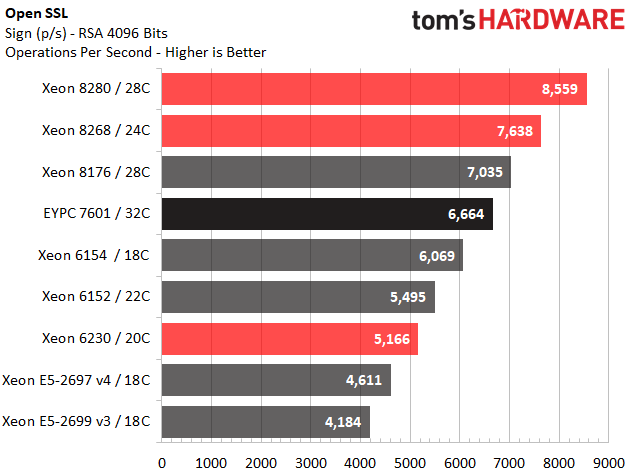
Intel worked diligently on accelerating encryption/decryption from several angles, as we measured in the Core i9-7900X Review. Our Intel test system comes outfitted with Intel's QuickAssist Technology, which boosts performance in a range of encryption/decryption tasks.
MORE: Best CPUs
MORE: Intel & AMD Processor Hierarchy
MORE: All CPU Content
Current page: Linux Compile, Unix Bench, NASPB
Prev Page Test Platforms and How We Test Next Page Sysbench, Stream, C-Ray, 7-Zip
Paul Alcorn is the Editor-in-Chief for Tom's Hardware US. He also writes news and reviews on CPUs, storage, and enterprise hardware.
-
Murissokah In the first page there's a paragraph stating "Like the previous-gen Xeon Scalable processors, Intel's Cascade Lake models drop into an LGA 4637 interface (Socket P) on platforms with C610 (Lewisburg) platform controller hubs, and the processors are compatible with existing server boards."Reply
Wouldn't that be LGA 3647? And shouldn't it read C620-famliy chipset for Lewisburg? -
JamesSneed It just hit me how big of a deal EPYC will be. AMD is already pulling lower power numbers with the 32 core 7601 however AMD will have a 64 core version with Zen2 and has stated the power draw will be about the same. If the power draw is truly is the same, AMD's 64 core Zen2 parts will be pulling less power than Intel's 28 core 8280. That is rather insane.Reply -
Amdlova lol 16x16gb 2666 for amdReply
8x32gb intel 2400
12x32gb intel 2933
How To incrase power compsumation to another level. add another 30w in memory for the amd server and its done. -
Mpablo87 The promise or realityReply
Cascade Lake Xeons employ the same microarchitectur as their predecessors, but, we can hope, it is promising!) -
The Doodle Slight problem this author fails to tell you in this article and that's OEM's can only buy the Platinum 9000 processor pre-mounted on Intel's motherboards. That's correct. None of the OEM's are likely to ship a solution based on this beast because of this fact. So at best you will be able to buy it from an Intel reseller. So forget seeing it from Dell, HPE, Lenovo, Supermico and others. your in white box territory.Reply
Besides, why would they? A 64C 225W AMD Rome will run rings around this space heater and cost a whole lot less.

